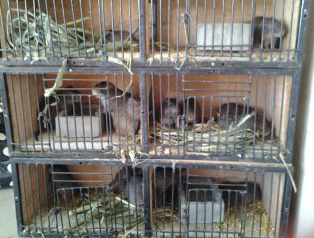
Image source:Google
Introduction to grass-cutter farming
The practice of grass-cutter farming has grown steadily in West Africa over the past couple of years. These rodents also known as “The Cane Rat” or “bush meat”, generally live by the meadows, clearings, muddy territories, reed-beds, and river banks in sub Saharan Africa.
According to startupdailytips.com, grass-cutter farming is the rearing of grass-cutters both for domestic and commercial use.
Importance of grass-cutter farming cannot be over emphasized in providing animal protein of high biological value. The meat is a delicacy in Africa and Nigeria in particular.
This meat compare favourably with pork, beef, poultry meat e.t.c which are all conventional source of protein.
Meat could be boiled, fried, roasted and toasted. Grass-cutter farming is well known in Africa, it can be practiced in urban, peri-urban and rural area.
Requirements for setting up Grass-cutter farming:
In order to start grass-cutter farming, there are some certain factors to be considered. These are;
Grass-cutter cage or pen
The grass-cutter cage or pen has to be built to be adequately spacious. And regions must be duly separated that is where

A Typical grasscutter cage.
Image source:google
they sleep should be different from where they carry out any form of activities because grass-cutters hate to sleep where they feed.
Ratios of placing them should be 1 male to 4 or 6 females because if 2 grown males are placed together, both of them would fight till one is dead. But by the ratio of 1 male to 4 or 6 females, they would live peacefully and there would be a rich reproduction rate.
The cage should also keep the colonies secure from potential pests like snakes, soldier ants, and humans. One can ensure ants have no access by pouring engine oils around their pens, and surrounding areas especially during rainy seasons.
Choosing a breed
In choosing a grass-cutter breed one wants to rear, it’s important to select one that’s most demanded in one’s country or that is accepted in the regions that one wants to ship it to. Once one has determined what breed he intends to rear, one should purchase 4 healthy females and one healthy male for a start to make one colony.
Healthy state of grass-cutters is crucial to aid rapid reproduction. Since fertility is the most important thing in rearing animals, there should be adequate purchase of very strong healthy grass-cutters.
Feeding the grass-cutters
Feeding grass-cutters is a lot cheaper than any other farm animal. Since they are herbivorous animals, the bulk of their diet lies majorly on grass. The most common grasses they are fed with are Napier grass or Elephant grass. They could also be congo grass, guinea grass, groundnut, maize, cassava, sweet potato, rice ,legumes, plantain, pawpaw ,pineapple, roots of oil and coconut palms, and most importantly sugar cane.
Constant feeding of grass-cutter with rich and healthy meals at all intervals results to gaining of weight quickly and reaching market size within a short time.
Benefits of Grass-cutter Farming
It is a source of income and employment
It is great source of protein
It is more cheaper to run than poultry, fish, or pig farming
It is good for people with blood related diseases such as hypertension.
Mode of feeding is not expensive, can be fed sometimes with grass only.
They can be reared at home.
They have more demand than available supply
When reared well, they sell for great prices.
Conclusion
Grass-cutter farming is one of the overlooked agribusinesses that turn in high revenues. With only about 0.2% grown domestically out of about 80,000 tons of grass-cutters consumed yearly in Nigeria, the opportunities for scale exceeds most farmer’s expectations.
Here, we are going to do a short analysis on income made by grass-cutter farmers.
According to startuptipdaily.com, the initial start-up capital for a farmer (naira values) was as follows.
1 colony which equals 5 grass-cutters (1 healthy male and 4 healthy females) costs #55000.
Then he decided to start with 5 colonies = 25 grass-cutters which costs #275000.
Cage and housing costs #80000 for 5 colonies, feeding costs #40000 per year.
Total amount of money = #395,000
Expected income
Since 1 female gives birth to an average of 4 to 10 grass-cutters within 6 months, 5 females will give birth to an average of 20 to 50 grass-cutters within 6 months.
And so 20 grass-cutters multiplied by 5 colonies equals 100 grass-cutters within 6 months.
In one year, one would be expecting at least 200 grass-cutters. The grass-cutters weigh between 6 to 10kg at maturity.
1 grass-cutter sells for #8000, #8000 multiplied by 200 grass-cutters equals #1,600,000.
And so, from the analysis so far ,it can be implied that grass-cutter farming is a very good agribusiness, if one invests #395,000 in it, within 53 weeks or less(if the grass-cutters reproduce at a very high rapid rate),one could make #1.6 million or more from it.
Reference:
http://startuptipsdaily.com/grasscutter-farming-in-nigeria/

Nice write-up, but I would really like to know more on the breeds of grass cutters available in Nigeria.
Thanks dear. I will work on that.
Follow me for upvotes | Send 0.200 Steem or 0.200 SBD and the URL in the memo to use the bot for a resteem and to get over 5 upvots.
Following all ready
Resteemed By @tisko
Thank you for using my service! @theagriculturist
You are welcome. It's nice dealing with you.
this post resteemed by group of @mrbean1

Thanks. It's nice dealing with you.
you re welcome
i you send to me 0,500 sbd I GIVE YOU 20 UPVOTE AND RESTEEM
info more informations https://steemit.com/support/@mrbean1/44jssn-support-people-in-steemit
it's cool , I give you my vote if you want to give me your upvote, thank you in advance...
nice post